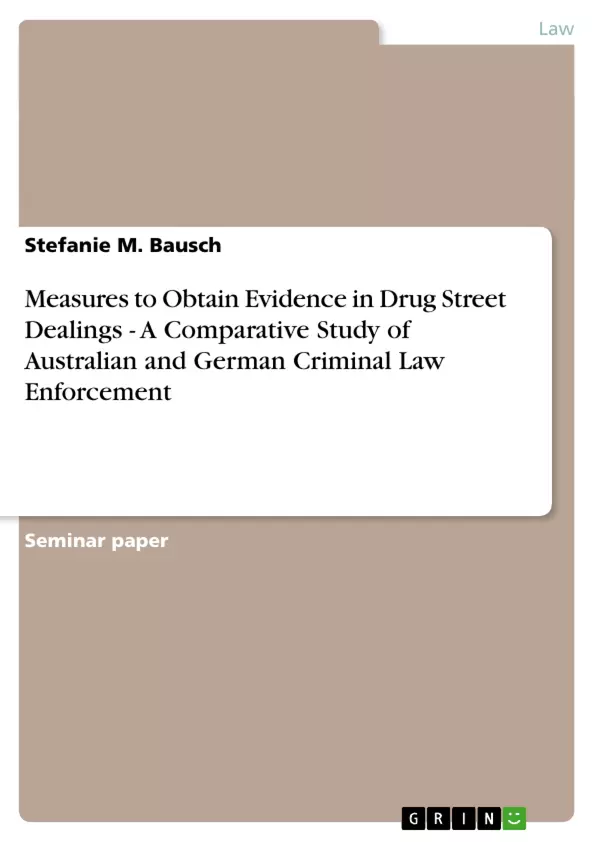Drugs have always been and will continue to be a vice of human society. They cause “harm to [both] users [and] their families”, are a danger to the users’ health, and impose enormous costs on society, especially on the public health system. Moreover, a correlation between the use of drugs and other crimes can be found (drug-crime nexus) because their addiction often forces users to commit other offences in order to finance their habit (drugs-related crime). Therefore, drugs can be looked at as a threat to the welfare of community.
Although changing attitudes and/or recreational activities might alter which kind of drug is favoured the most at the time being, the core problem stays the same over time. Therefore, how to deal with drug crimes and related issues is a topic that remains contemporary and is always worth considering.
The following research paper examines drug law enforcement measures in cases of street dealings in both Australia and Germany. But first, it is necessary to give a brief general overview over the differences between the two legal systems with regard to drug offences and their enforcement.
Inhaltsverzeichnis (Table of Contents)
- Introduction
- Drug Offences and their Enforcement
- Measures to obtain evidence in Australia
- Australian Capital Territory
- New South Wales
- Northern Territory
- Queensland
- South Australia
- Tasmania
- Victoria
- Western Australia
- Brief Summary of the measures to obtain evidence in the Australian States
- Measures to obtain evidence in Germany
- Conclusion
Zielsetzung und Themenschwerpunkte (Objectives and Key Themes)
This comparative study aims to analyze and contrast the legal frameworks and practices employed in Australia and Germany regarding evidence gathering in cases of drug street dealings. The study delves into the specific measures available to law enforcement agencies in both countries, examining their effectiveness and potential limitations. It explores the challenges faced by law enforcement in combating drug trafficking and the legal considerations surrounding the collection of evidence.
- Comparative analysis of drug street dealing laws in Australia and Germany
- Examination of evidence gathering measures in both jurisdictions
- Assessment of the effectiveness and limitations of these measures
- Exploration of legal considerations and challenges in combating drug trafficking
- Discussion of the potential impact of legal frameworks on drug enforcement strategies
Zusammenfassung der Kapitel (Chapter Summaries)
- The introduction sets the stage for the comparative study, outlining the objectives and scope of the research. It highlights the significance of understanding the legal frameworks and practices surrounding evidence gathering in drug street dealing cases.
- Chapter II delves into the nature of drug offenses and the complexities of their enforcement. It examines the legal definitions of drug offenses in both Australia and Germany, outlining the different types of drugs and their associated penalties. Additionally, it explores the challenges faced by law enforcement in combating drug trafficking and the evolving nature of drug-related crime.
- Chapter III provides a comprehensive overview of the measures available to obtain evidence in drug street dealing cases in Australia. It analyzes the legal framework and investigative powers granted to law enforcement agencies in each Australian state and territory, highlighting the similarities and differences in their approaches.
- Chapter IV shifts the focus to Germany, presenting a detailed analysis of the legal provisions and investigative tools used in the country to gather evidence in drug street dealing cases. It examines the specific powers granted to German law enforcement and the legal limitations they face.
Schlüsselwörter (Keywords)
This comparative study focuses on the key concepts of drug street dealing, evidence gathering, criminal law enforcement, comparative law, Australian law, German law, drug trafficking, police powers, legal framework, investigative techniques, and legal limitations.
- Citar trabajo
- Dr. Stefanie M. Bausch (Autor), 2004, Measures to Obtain Evidence in Drug Street Dealings - A Comparative Study of Australian and German Criminal Law Enforcement, Múnich, GRIN Verlag, https://www.grin.com/document/29779



